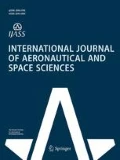Abstract
This paper proposes generalized polynomial guidance for controlling the terminal velocity vector (speed and flight path angle), which could be critical for the effectiveness of the warhead of tactical ballistic missiles. A polynomial reference trajectory satisfying the initial and terminal altitudes and flight path angles is introduced with a guidance parameter that can be chosen to change the terminal speed. A single differential equation of the speed along the reference trajectory is then derived and an iterative search method for determining the guidance parameter to satisfy the prescribed terminal speed is proposed. Numerical simulation study with various impact angle and terminal speed constraints is conducted to demonstrate the performance of the proposed guidance method for terminal velocity control. Robustness of the proposed method to drag variations is also investigated to check the feasibility of generalized polynomial guidance for a practical purpose.






Similar content being viewed by others
References
Hargraves CR, Paris SW (1987) Direct trajectory optimization using nonlinear programming and collocation. J Guid Control Dyn 10(4):338–342
Von Stryk O, Bulirsch R (1992) Direct and indirect methods for trajectory optimization. Ann Oper Res 37(1):357–373
Herman AL, Conway BA (1996) Direct optimization using collocation based on high-order Gauss-Lobatto quadrature rules. J Guid Control Dyn 19(3):592–599
Fahroo F, Ross IM (2002) Direct trajectory optimization by a Chebyshev pseudospectral method. J Guid Control Dyn 25(1):160–166
Rea J Launch vehicle trajectory optimization using a Legendre pseudospectral method. In: AIAA guidance, navigation, and control conference and exhibit, 2003. p 5640
Benson DA, Huntington GT, Thorvaldsen TP, Rao AV (2006) Direct trajectory optimization and costate estimation via an orthogonal collocation method. J Guid Control Dyn 29(6):1435–1440
Rosa Sentinella M, Casalino L Genetic algorithm and indirect method coupling for low-thrust trajectory optimization. In: 42nd AIAA/ASME/SAE/ASEE Joint Propulsion Conference & Exhibit, 2006. p 4468
Yong E-m, Tang G-j, Chen L (2008) Rapid trajectory optimization for hypersonic reentry vehicle via gauss pseudospectral method. J Astronaut 29(6):1766–1772
Morari M, Lee JH (1999) Model predictive control: past, present and future. Comput Chem Eng 23(4–5):667–682
Rawlings JB, Mayne DQ (2009) Model predictive control: Theory and design.
Baldwin M, Kolmanovsky I Hypersonic glider guidance using model predictive control. In: American Control Conference (ACC), 2013, 2013. IEEE, pp 5550–5555
Padhi R, Kothari M (2009) Model predictive static programming: a computationally efficient technique for suboptimal control design. Int J Innov Comput Inform Control 5(2):399–411
Oza HB, Padhi R (2012) Impact-angle-constrained suboptimal model predictive static programming guidance of air-to-ground missiles. J Guid Control Dyn 35(1):153–164
Halbe O, Raja RG, Padhi R (2013) Robust reentry guidance of a reusable launch vehicle using model predictive static programming. J Guid Control Dyn 37(1):134–148
Maity A, Oza HB, Padhi R (2014) Generalized model predictive static programming and angle-constrained guidance of air-to-ground missiles. J Guid Control Dyn 37(6):1897–1913
Sturm JF (2002) Implementation of interior point methods for mixed semidefinite and second order cone optimization problems. Optim Methods Softw 17(6):1105–1154
Andersen ED, Roos C, Terlaky T (2003) On implementing a primal-dual interior-point method for conic quadratic optimization. Math Prog 95(2):249–277
Blackmore L, Acikmese B, Scharf DP (2010) Minimum-landing-error powered-descent guidance for Mars landing using convex optimization. J Guid Control Dyn 33(4):1161–1171
Liu X, Lu P (2014) Solving nonconvex optimal control problems by convex optimization. J Guid Control Dyn 37(3):750–765
Liu X (2013) Autonomous trajectory planning by convex optimization.
Liu X, Shen Z, Lu P (2015) Entry trajectory optimization by second-order cone programming. J Guid Control Dyn 39(2):227–241
Lu P, Liu X (2013) Autonomous trajectory planning for rendezvous and proximity operations by conic optimization. J Guid Control Dyn 36(2):375–389
Ohlmeyer EJ, Phillips CA (2006) Generalized vector explicit guidance. J Guid Control Dyn 29(2):261–268
Ryoo C-K, Cho H, Tahk M-J (2005) Optimal guidance laws with terminal impact angle constraint. J Guid Control Dyn 28(4):724–732
Ryoo C-K, Cho H, Tahk M-J (2006) Time-to-go weighted optimal guidance with impact angle constraints. IEEE Trans Control Syst Technol 14(3):483–492
Min B-M, Tahk M-J, Shim H-C, Bang H-C, Guidance law for vision-based automatic landing of UAV. KSAS International Journal 8(1): 46–53
Lee C-H, Kim T-H, Tahk M-J, Whang I-H (2013) Polynomial guidance laws considering terminal impact angle and acceleration constraints. IEEE Trans Aerosp Electron Syst 49(1):74–92
Kim T-H, Lee C-H, Jeon I-S, Tahk M-J (2013) Augmented polynomial guidance with impact time and angle constraints. IEEE Trans Aerosp Electron Syst 49(4):2806–2817
Tahk M-J, Moon G-H, Shim S-W (2019) Augmented polynomial guidance with terminal speed constraints for unpowered aerial vehicles. Int J Aeronaut Space Sci 20(1):183–194
Ahn J, Roh W-R (2012) Noniterative instantaneous impact point prediction algorithm for launch operations. J Guid Control Dyn 35(2):645–648
Chudinov PS (2002) The motion of a heavy particle in a medium with quadratic drag force. Int J Nonlinear Sci Numer Simul 3(2):121–130
Chudinov PS (2010) Approximate formula for the vertical asymptote of projectile motion in midair. Int J Math Educ Sci Technol 41(1):92–98
Han S, Hwang M-C, Lee B-Y, Ahn J, Tahk M-J (2016) Analytic solution of projectile motion with quadratic drag and unity thrust. IFAC-PapersOnLine 49(17):40–45
Acknowledgements
This work was supported by Hanwha Corporation Defense R&D Center.
Author information
Authors and Affiliations
Corresponding author
Additional information
Publisher's Note
Springer Nature remains neutral with regard to jurisdictional claims in published maps and institutional affiliations.
Rights and permissions
About this article
Cite this article
Moon, GH., Tahk, MJ., Han, D.H. et al. Generalized Polynomial Guidance for Terminal Velocity Control of Tactical Ballistic Missiles. Int. J. Aeronaut. Space Sci. 22, 163–175 (2021). https://doi.org/10.1007/s42405-020-00291-6
Received:
Revised:
Accepted:
Published:
Issue Date:
DOI: https://doi.org/10.1007/s42405-020-00291-6




